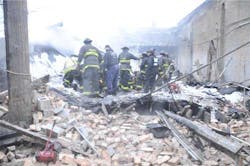Chicago FD Faulted in Deaths of Two Firefighters
The report by the National Institute for Occupational Safety and Health also pointed to the lack of a system to alert the Fire Department to hazardous buildings as among the "contributing factors" that cumulatively put firefighters at risk.
The report said few of the firefighters who were sent into the vacant, dilapidated building in the 1700 block of East 75th Street on Dec. 22 had radios and that supervisors outside the building had no idea what the firefighters inside were seeing: flames crawling up wooden beams to the ceiling.
As the firefighters fought the blaze from the inside, others were on the roof, spraying water and cutting holes to vent smoke right up until the roof collapsed. Two firefighters inside the building, Edward Stringer, 47, and Corey Ankum, 34, were killed, and 19 other firefighters were injured.
Tim Merinar, who led the federal agency's investigation, said Fire Department supervisors should have taken a more defensive approach and ordered more firefighters out of the building once it was clear that no one was trapped inside, as firefighters had feared when they arrived at the early morning blaze.
The Fire Department received the report in July and has already implemented some of the agency's recommendations, department spokesman Larry Langford said Thursday.
The Fire Department now requires that firefighters inside a building provide more details to commanders about the situation, Langford said.
The department has also begun hanging tags on each firetruck that identify every firefighter assigned to the vehicle, in response to the report's recommendation that the department improve its ability to account for all firefighters working at a specific incident.
But one major recommendation -- putting radios in the hands of every firefighter -- won't be implemented until sometime in 2012, when the city's Office of Emergency Management and Communication says a much-delayed digital radio system will be operational.
The department currently provides a radio to one member of each team of two or three firefighters, Langford said.
Only five of the 13 firefighters who were in the building when the roof collapsed had radios, and none of those firefighters provided supervisors outside the building with a description of the conditions inside, the report said.
All firefighters in New York City and Los Angeles are equipped with hand-held radios, according to those departments. In Los Angeles, that's been the policy for more than a decade, a department spokeswoman said.
In New York, all firefighters have been equipped with radios since the Sept. 11 attacks, Fire Department spokesman Jim Long said. The department has implemented several backups into its communications systems and now uses repeaters on battalion vehicles that amplify the signal of radio communications among firefighters at scenes.
The report also cited the lack of information firefighters receive about dangerous buildings. City inspectors in 2007 had ordered the owners of the abandoned laundry building to repair the roof, but after the fire, the owner told the Tribune he couldn't afford the repairs and simply tried to keep it boarded up.
Firefighters weren't aware of the roof's danger because the city's Department of Buildings did not have a procedure for notifying the Fire Department of hazardous buildings, the report says.
The report recommends that the city follow New York's lead by posting signs on hazardous vacant buildings to alert firefighters to the dangers inside. Langford said the Fire Department is working to map and mark dangerous buildings and is identifying structures that need to be demolished.
Supervisors on the street also were handicapped by a lack of information, according to the report. Unaware that the roof was already weak, and that what began as a rubbish fire was spreading into the ceiling, they allowed firefighters to stay inside and on the roof as conditions deteriorated, the report said.
Firefighters did the right thing by searching the building for homeless people who might have been trapped, but "the (number) of firefighters inside the structure clearly exceeded the number needed to suppress the amount of fire present and to search the vacant structure," according to the report.
Investigators of fires where firefighters are killed often find that communication breaks down as firefighters inside a building focus on their immediate tasks -- such as searching for occupants or tearing down walls -- and don't relay regular updates to commanders, Merinar said.
Stringer's mother called the federal report "very disturbing" and said she was particularly alarmed by the city's failure to inform the Fire Department about dangerous buildings.
"There's a lack of communication, a lack of knowledge that is passed on to these firefighters," said Joyce Lopez. "They're the ones doing the job, and they don't know what the heck they're going to encounter."
Tribune reporters Becky Schlikerman and Cynthia Dizikes contributed.
McClatchy-Tribune News Service
